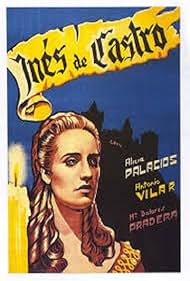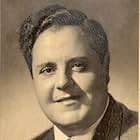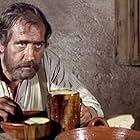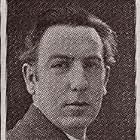Dom Pedro, heir to the Portuguese crown, is married to a Castilian princess but falls in love for his wife's maid. In addition to sin and scandal, can they survive the political implications... Read allDom Pedro, heir to the Portuguese crown, is married to a Castilian princess but falls in love for his wife's maid. In addition to sin and scandal, can they survive the political implications of their romance?Dom Pedro, heir to the Portuguese crown, is married to a Castilian princess but falls in love for his wife's maid. In addition to sin and scandal, can they survive the political implications of their romance?
- Awards
- 1 win
Photos
Storyline
Featured review
Vintage Iberian historical movie including intense drama , evocative clothing , costumes and adequate set design . Epic and acceptable film dealing with kingdoms , passions , court confrontations , treason and political intrigues . It concerns Infante Pedro (Antonio Vilar) who married Spanish princess Constanza (Maria Dolores Pradera) , but Pedro fell for her servant Ines de Castro (Alicia Principe) , she was a Galician noblewoman best known as lover and posthumously-recognized wife of King Peter I of Portugal.
This is an impressive historic tale set in Portugal , concerning fights , love stories , faith , religion and terrifying elements on its ending . There takes place the politic intrigues in the kingdom and then multiple drama is inevitable with a political confrontation behind . This interesting as well as intimate story is a passionate retelling and a touching drama , adding creepy happenings . The settings are decent though mostly made in ¨Carton-Piedra (stone)¨ as well as matte-painting . The motion picture was professionally directed by José Leitão de Barros who directed a lot of documentary and ¨Camoens¨ also starred by Antonio Vilar.
Based on historical facts , these are the following ones : Ines de Castro came to Portugal in 1340 as a maid of Constance of Castile, recently married to Peter, the heir apparent to the Portuguese throne. The prince fell in love with her and started to neglect his lawful wife, endangering the already feeble relations with Castile . Moreover, Peter's love for Ines brought the exiled Castilian nobility very close to power, with Inês's brothers becoming the prince's friends and trusted advisors. King Afonso IVThe Brave of Portugal, Peter's father, disliked Ines's influence on his son and waited for their mutual infatuation to wear off, but it did not. Then Constance of Castile died in 1345. Alfonso IV tried several times to arrange for his son to be remarried, but Pedro refused to take a wife other than Ines, who was not deemed eligible to be queen. Peter's legitimate son, future King Ferdinand I of Portugal, was a frail child, whereas Peter and Ines's illegitimate children were thriving; this created even more discomfort among the Portuguese nobles, who feared the increasing Castilian influence over Peter. Afonso IV banished Ines from the court after Constance's death, but Peter remained with her declaring her as his true love. After several attempts to keep the lovers apart, Afonso IV ordered Inês's death. Pêro Coelho, Álvaro Goncalves, and Diego Lopes Pacheco went to the Monastery of Santa Clara-a-Velha in Coimbra, where Ines was detained, and killed her, decapitating her in front of her small child. When Peter heard of this he sought out the killers and managed to capture two of them in 1361. He executed them publicly by ripping their hearts out, claiming they didn't have one after having pulverized his own heart. Peter became king of Portugal in 1357 (Peter I of Portugal). He then stated that he had secretly married Inês, who was consequently the lawful queen, although his word was, and still is, the only proof of the marriage. During the 1383-85 Crisis of royal succession in Portugal, João das Regras produced evidence that allegedly established that Pope Innocent IV had refused Peter's request to recognize his marriage to Inês and legitimize his children by her, the elder of whom, John, Duke of Valencia de Campos would have a strong potential claim to the throne of Portugal. By negating these children's claimed legitimacy, João das Regras strengthened the claim of another illegitimate child of Peter I of Portugal: John, Master of Aviz, who ultimately took the throne and ruled as John I of Portugal .Some sources say that after Peter became king of Portugal, he had Inês' body exhumed from her grave and forced the entire court to swear allegiance to their new queen: "The king caused the body of his beloved Ines to be disinterred, and placed on a throne, adorned with the diadem and royal robes. and required all the nobility of the kingdom to approach and kiss the hem of her garment, rendering her when dead that homage which she had not received in her life..." Some modern sources characterize the story of the Ines' post-mortem coronation is a "legend. And it is most likely a myth, since the story only appeared in 1577 in Jerónimo Bermúdez' play . She was later buried at the Monastery of Alcobaca where her coffin can still be seen, opposite Peter's so that, according to the legend, at the Last Judgment Peter and Ines can look at each other as they rise from their graves.
This is an impressive historic tale set in Portugal , concerning fights , love stories , faith , religion and terrifying elements on its ending . There takes place the politic intrigues in the kingdom and then multiple drama is inevitable with a political confrontation behind . This interesting as well as intimate story is a passionate retelling and a touching drama , adding creepy happenings . The settings are decent though mostly made in ¨Carton-Piedra (stone)¨ as well as matte-painting . The motion picture was professionally directed by José Leitão de Barros who directed a lot of documentary and ¨Camoens¨ also starred by Antonio Vilar.
Based on historical facts , these are the following ones : Ines de Castro came to Portugal in 1340 as a maid of Constance of Castile, recently married to Peter, the heir apparent to the Portuguese throne. The prince fell in love with her and started to neglect his lawful wife, endangering the already feeble relations with Castile . Moreover, Peter's love for Ines brought the exiled Castilian nobility very close to power, with Inês's brothers becoming the prince's friends and trusted advisors. King Afonso IVThe Brave of Portugal, Peter's father, disliked Ines's influence on his son and waited for their mutual infatuation to wear off, but it did not. Then Constance of Castile died in 1345. Alfonso IV tried several times to arrange for his son to be remarried, but Pedro refused to take a wife other than Ines, who was not deemed eligible to be queen. Peter's legitimate son, future King Ferdinand I of Portugal, was a frail child, whereas Peter and Ines's illegitimate children were thriving; this created even more discomfort among the Portuguese nobles, who feared the increasing Castilian influence over Peter. Afonso IV banished Ines from the court after Constance's death, but Peter remained with her declaring her as his true love. After several attempts to keep the lovers apart, Afonso IV ordered Inês's death. Pêro Coelho, Álvaro Goncalves, and Diego Lopes Pacheco went to the Monastery of Santa Clara-a-Velha in Coimbra, where Ines was detained, and killed her, decapitating her in front of her small child. When Peter heard of this he sought out the killers and managed to capture two of them in 1361. He executed them publicly by ripping their hearts out, claiming they didn't have one after having pulverized his own heart. Peter became king of Portugal in 1357 (Peter I of Portugal). He then stated that he had secretly married Inês, who was consequently the lawful queen, although his word was, and still is, the only proof of the marriage. During the 1383-85 Crisis of royal succession in Portugal, João das Regras produced evidence that allegedly established that Pope Innocent IV had refused Peter's request to recognize his marriage to Inês and legitimize his children by her, the elder of whom, John, Duke of Valencia de Campos would have a strong potential claim to the throne of Portugal. By negating these children's claimed legitimacy, João das Regras strengthened the claim of another illegitimate child of Peter I of Portugal: John, Master of Aviz, who ultimately took the throne and ruled as John I of Portugal .Some sources say that after Peter became king of Portugal, he had Inês' body exhumed from her grave and forced the entire court to swear allegiance to their new queen: "The king caused the body of his beloved Ines to be disinterred, and placed on a throne, adorned with the diadem and royal robes. and required all the nobility of the kingdom to approach and kiss the hem of her garment, rendering her when dead that homage which she had not received in her life..." Some modern sources characterize the story of the Ines' post-mortem coronation is a "legend. And it is most likely a myth, since the story only appeared in 1577 in Jerónimo Bermúdez' play . She was later buried at the Monastery of Alcobaca where her coffin can still be seen, opposite Peter's so that, according to the legend, at the Last Judgment Peter and Ines can look at each other as they rise from their graves.
Details
- Runtime1 hour 32 minutes
- Color
- Sound mix
- Aspect ratio
- 1.37 : 1
Contribute to this page
Suggest an edit or add missing content












